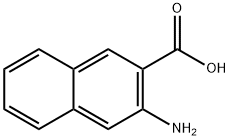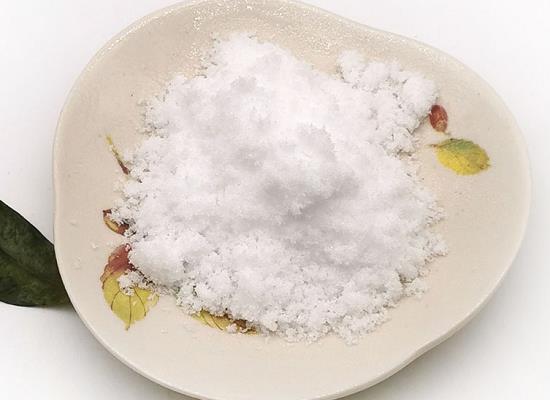3-Amino-2-naphthoic acid: properties, applications and safety
General Description
3-Amino-2-naphthoic acid is a white crystalline solid with limited solubility in water but dissolves well in organic solvents. It exhibits both acidic and weak basic properties and finds utility in the synthesis of dyes and pigments. Additionally, it has been developed as a "turn-on" fluorescence probe for the specific detection of the cyanate anion, which is a biomarker for certain diseases such as chronic kidney disease. However, it is important to handle this substance with care due to potential health risks such as skin and eye irritation, respiratory problems, and toxicity if ingested. Proper protective equipment and handling procedures should be employed to ensure safety when working with this compound.

Figure 1. 3-Amino-2-naphthoic acid
Properties
3-Amino-2-naphthoic acid is an organic compound with a chemical formula C11H9NO2. It is a derivative of naphthalene and contains both an amino group (-NH2) and a carboxylic acid group (-COOH) attached to the naphthalene ring. One of the notable properties of 3-Amino-2-naphthoic acid is its white to yellow crystalline appearance. It has a melting point of approximately 212-215°C, making it a solid at room temperature. It is sparingly soluble in water but dissolves well in organic solvents such as ethanol and acetone. 3-Amino-2-naphthoic acid possesses both acidic and basic properties. The carboxylic acid group can donate a proton, making it slightly acidic. On the other hand, the amino group can accept a proton, giving it weak basic characteristics. This compound is commonly used as a building block in the synthesis of various dyes and pigments. Its structural features and aromaticity make it suitable for applications in the field of organic chemistry and materials science. In summary, 3-Amino-2-naphthoic acid is a yellow crystalline solid with a melting point of 207-209°C. It has limited solubility in water but dissolves well in organic solvents. It exhibits both acidic and weak basic properties and finds utility in the synthesis of dyes and pigments. 1
Applications
3-Amino-2-naphthoic acid has been developed as a "turn-on" fluorescence probe for the specific detection of the cyanate anion (CNO-). The cyanate anion is a biomarker for certain diseases, such as chronic kidney disease. Accurate determination of CNO- is crucial in diagnosing and monitoring these diseases. 3-Amino-2-naphthoic acid probe exhibits weak fluorescence until it reacts with CNO-. Upon addition of sodium cyanate, the interaction between the probe and CNO- triggers a significant increase in green fluorescence emission, with up to a 9-fold enhancement observed. This fluorescence enhancement shows a good linear relationship with CNO- concentrations ranging from 0.5 to 200 μM. The probe demonstrates high selectivity and sensitivity for CNO- detection, with a low detection limit of 260 nM. It has successfully been applied to determine CNO- in various real samples, including tap water, human urine, and serum samples. In summary, 3-Amino-2-naphthoic acid-based fluorescence probe provides a promising approach for the specific and sensitive detection of CNO-. Its applications in disease diagnosis and monitoring, particularly in chronic kidney disease, make it valuable in practical settings. 2
Safety
3-Amino-2-naphthoic acid is a chemical compound commonly used in the manufacturing of dyes, pharmaceuticals, and organic synthesis. However, it is important to note that this substance poses certain safety risks that must be taken into consideration. When ingested, 3-Amino-2-naphthoic acid can be harmful and toxic to the body. It can cause serious health effects such as vomiting, nausea, and even death in extreme cases. Furthermore, this substance can also irritate the skin, causing redness and discomfort upon contact. If it comes into contact with the eyes, it can cause serious eye irritation that may require medical attention. In addition, inhalation of this substance may cause respiratory irritation, which can lead to coughing, shortness of breath, and other respiratory problems. To ensure safety when handling 3-Amino-2-naphthoic acid, proper protective equipment and handling procedures should be employed. This includes wearing gloves, goggles, and a mask when working with the substance. Adequate ventilation should also be provided to prevent inhalation of the substance's fumes. In summary, while 3-Amino-2-naphthoic acid has many practical uses, it must be handled with care and caution to avoid any potential hazards or health risks. 3
Reference
1. PubChem. COMPOUND SUMMARY: 3-Amino-2-naphthoic acid. National Library of Medicine, PubChem CID: 22244.
2. Feng J, Zhong J, Tang X. Selective and sensitive detection of cyanate using 3-amino-2-naphthoic acid-based turn-on fluorescence probe. Anal Bioanal Chem. 2019 Jun;411(16):3613-3619.
3. 3-Amino-2-naphthoic acid. European Chemicals Agency, EC List no. 227-726-2.
);You may like
Related articles And Qustion
See also
Lastest Price from 3-Amino-2-naphthoic acid manufacturers

US $1.00/KG2019-12-31
- CAS:
- 5959-52-4
- Min. Order:
- 1KG
- Purity:
- 99%
- Supply Ability:
- 200kg



